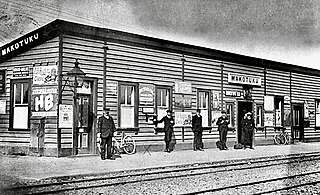Waipukurau is the largest town in the Central Hawke's Bay District on the east coast of the North Island of New Zealand. It is located on the banks of the Tukituki River, 7 kilometres south of Waipawa and 50 kilometres southwest of Hastings.

Takapau is a small rural community in the Central Hawkes Bay in New Zealand. It is located 20 kilometres west of Waipukurau, off State Highway 2, and has a population of more than 500.

Pukehou is a farming locality in southern Hawke's Bay, in the eastern North Island of New Zealand.

Ellerslie railway station serves the Southern and Onehunga Lines of the Auckland railway network in New Zealand. It was opened in 1873. It has an island platform and is 1.37 km (0.85 mi) south of Greenlane and 1.45 km (0.90 mi) north of Penrose.
Ōtāne is a town in the Central Hawke's Bay District and the Hawke's Bay region, on the east coast of New Zealand's North Island. The small village, has a school, general store, cafe and pub, and is located just off State Highway 2.

Edmund Giblett Allen (1844–1909) was a Liberal Party Member of Parliament in New Zealand.
Awatoto is a coastal suburb area within the city of Napier, Hawke's Bay, New Zealand. It stretches along the coast south of Te Awa and the central city. The northern part of Awatoto is residential, while the southern part is industrial, including heavy industry.

The Hastings railway station in Hastings, New Zealand is the main railway station in Hastings and an intermediate stop on the Palmerston North–Gisborne Line. The station is on the corner of Russell Street and St Aubyn Street, and is close to the centre of Hastings. It is no longer used by any regularly-scheduled passenger services.

The Napier railway station in Napier, New Zealand was the main railway station in Napier and an intermediate stop on the Palmerston North–Gisborne Line. On 12 October 1874 the station and the first section of the line south from Napier to Hastings was opened. The line through the Manawatū Gorge to Palmerston North and hence to Wellington was opened on 9 March 1891. The first train carrying passengers had been organised by the contractors, John Brogden and Sons, on Tuesday 30 June 1874 to run from Napier to Waitangi.

Raahui Pookeka-Huntly Railway Station is on the North Island Main Trunk line and the Awaroa Branch in the town of Huntly in the Waikato District of New Zealand, 65 mi (105 km) south of Auckland. It is 7.31 km (4.54 mi) north of Taupiri and 2.78 km (1.73 mi) south of Kimihia. The station was named Raahui Pookeka-Huntly for its reopening for the new Te Huia train on 6 April 2021.

Ormondville is a locality in the Manawatū-Whanganui region of New Zealand's North Island. It is located inland, south of Waipukurau and west of Flemington, Hawke's Bay.

Opaparailway station is a preserved station on the Palmerston North–Gisborne Line in New Zealand's North Island that closed in 1981. It is in the Hastings District of Hawke's Bay, 23.56 km (14.64 mi) south of Hastings city, in a census meshblock with a population of only 222 in 2018.

Matamau is a small village, on a ridge between the Matamau and Whakaruatapu Streams, tributaries of the Manawatū River, in the Manawatū-Whanganui region of New Zealand's North Island. State Highway 2 and the Palmerston North–Gisborne line run through the village. It has a rare surviving example of a basic railway station, a cafe, developed from the former post office and store about 1969, and a truck repair workshop. Until the 1870s it was densely forested, but most of the trees were felled and milled by 1910 and replaced by farms.

Makotuku is a locality in the Manawatu-Whanganui Region of New Zealand's North Island, about 3 km2 (1.2 sq mi) west of Ormondville.
Hatuma is 7 km (4.3 mi) south of Waipukurau, in Central Hawke's Bay in the east of the North Island of New Zealand. Meshblock 7016748, which covers 19.3 km2 (7.5 sq mi) from the edge of Waipukurau to Marakeke, had a population of 153 in 2018.

Kopua in New Zealand is now a sparsely populated area, immediately south of the border of the Manawatū-Whanganui and Hawke's Bay regions, with 150 people scattered over a 40 km2 (15 sq mi) meshblock. For two years it briefly flourished as a village, centred on a railway station on the Palmerston North–Gisborne line, opened on 25 January 1878, when it became the southern terminus of the line from Napier and Spit. Building to the south was delayed by the need to erect 3 large viaducts over the Manawatū River and its tributaries, so the extension to Makotuku didn't open until 9 August 1880. Kopua then declined until the station closed on 8 May 1977. Only a single line now passes through the station site and there are remnants of cattle yards.

Piripiri is a sparsely populated area in the Tararua District, in the Manawatū-Whanganui Region, on State Highway 2 and the Palmerston North–Gisborne line. It is 3 mi 8 ch (5.0 km) north of Dannevirke, and has 150 people scattered over a meshblock of 21.8 km2 (8.4 sq mi).

Mangatera railway station on the Palmerston North–Gisborne line of the North Island of New Zealand opened on 15 December 1884, as part of the 7 mi 43 ch (12.1 km) Matamau-Tahoraiti extension of the line from Napier.

Rissington is a farming settlement 15 km (9.3 mi) north west of Napier, New Zealand. It lies in Hawke's Bay Region, between Sherenden and Napier, in the Mangaone River valley, on the road to Patoka and Puketitiri. A fire station, cemetery and a war memorial are the only remaining public structures, but it once had several more and was home to the country's first Women's Institute, co-founded by Amy Hutchinson and Bessie Spencer.

From at least 1870 Waipawa was served by mail coaches running between Napier and Waipukurau.
















